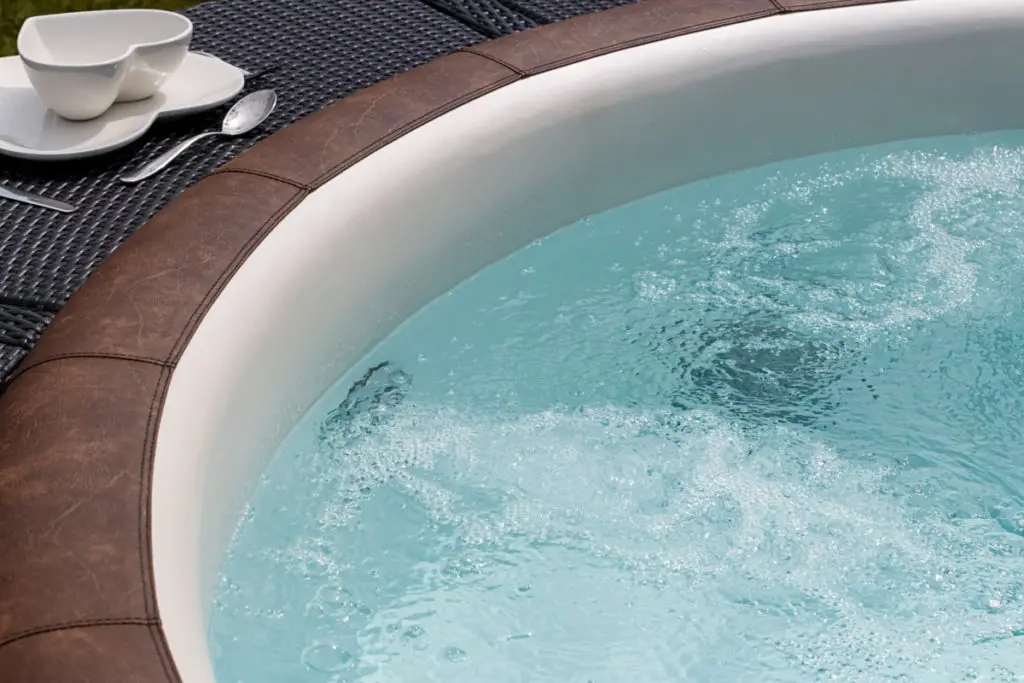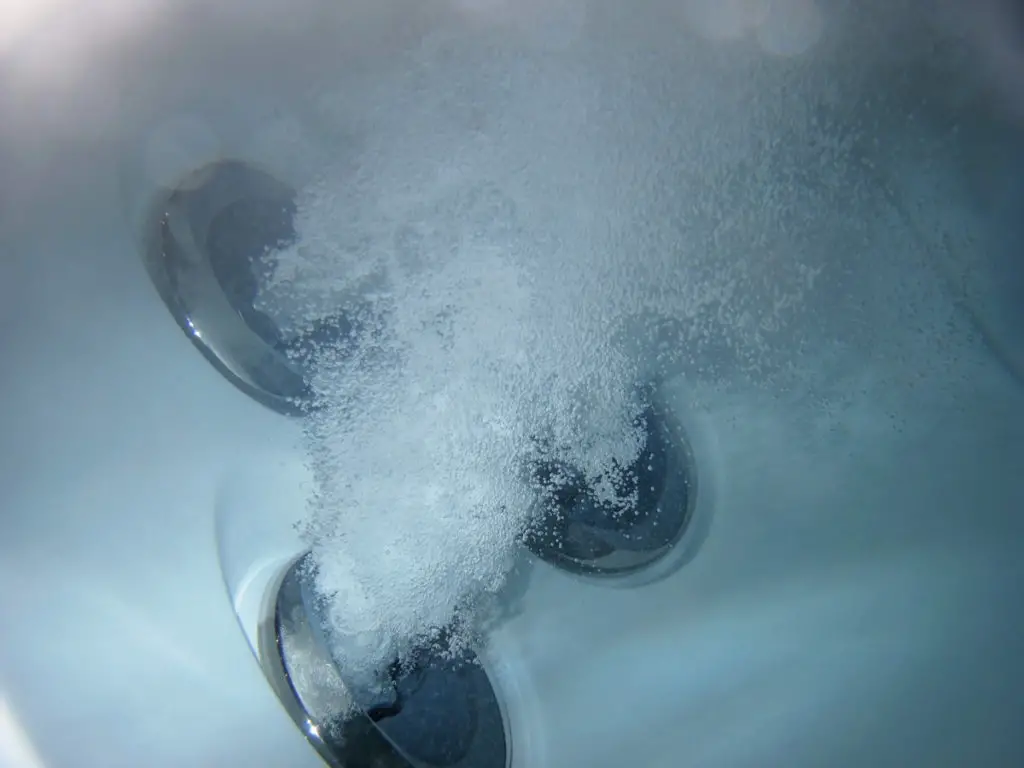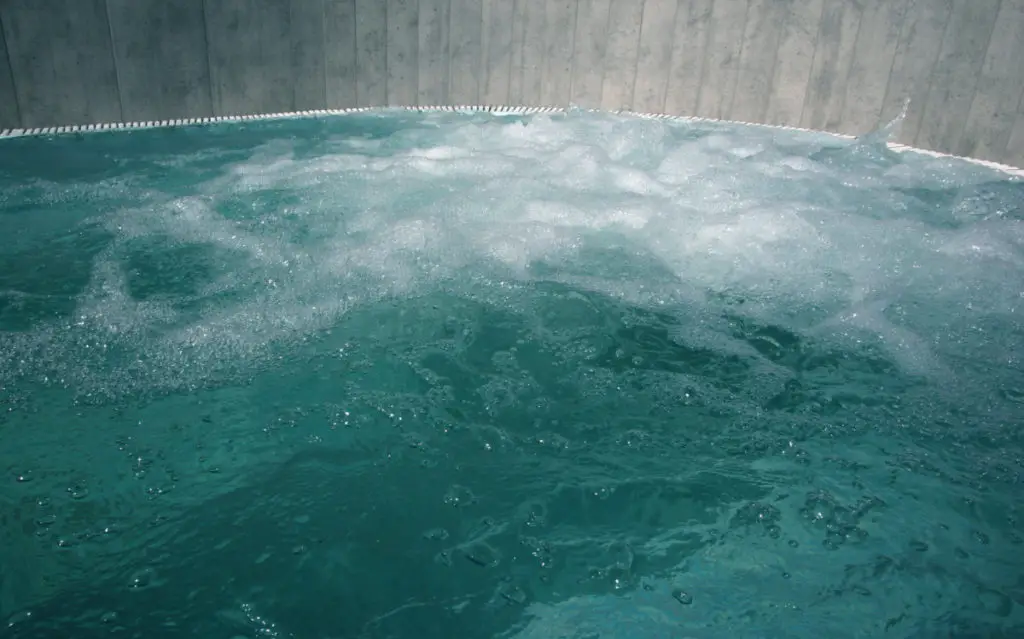This post contains affiliate links.
Inflatable hot tubs are popular with many hot tub buyers because of their price point, portability, and ease of setup. But are you giving anything up by choosing an inflatable version of something that can get quite expensive? A quintessential hot tub experience is the deep penetrating therapeutic massage from a great jet system. Can the same experience be achieved with an inflatable hot tub? Do they even have jets?

Most inflatable hot tubs have jets. The jet type and experience depend on the model of an inflatable hot tub much like a traditional hot tub. In most cases, inflatable hot tubs will have many small bubbler-style jets that produce a relaxing sensation that soothes rather than massages sore muscles.
Now that you know you can still get a soothing experience in an inflatable hot tub, let’s get into the details and see if an inflatable hot tub is the right choice for you.
What Is A Hot Tub Jet?
A hot tub jet system is the main reason why most people buy a hot tub. The right hot tub jet can provide relaxation, entertainment, and hydrotherapy. There are a vast number of hot tub jet types that are designed for different purposes.

A hot tub jet is simply described as a device that concentrates and directs the flow of water. The size, design, and placement of a jet are criteria used by hot tub manufacturers to tailor the hot tub experience. The size of a jet typically dictates the amount of flow that can be pushed through the jet nozzle. Flow is also dependent on the size and power of a hot tub pump. Large jets will consume the majority of a pump’s flow capacity.
Size can also be a determining factor in pressure as well. A high-flow pump and jet combination will push a lot of water and deeply penetrate large muscle groups providing a massaging, hydrotherapy experience. Small jets will constrict flow and provide a high-pressure output that can stimulate the surface nerves of our bodies. This can provide a relaxing experience that feels good, but will not penetrate deep into the muscle tissue.
The design of a hot tub jet is also important. By design, I am mainly talking about the pattern of flow coming out of a jet. A jet can be designed to produce many different types of flow patterns. Pulsing, spinning, bubbling, and blasting (I am using blasting as a technical term for describing a jet that is designed to push as much water as possible), flow patterns are used to provide a unique experience and are intended for specific purposes.
Placement is just as important as size and design. Placement can be argued to be the most important factor when considering a hot tub jet. Targeting large muscle groups with low-flow high-pressure jets may feel great, but it isn’t going to provide any therapeutic benefit because large muscle groups need high flow to penetrate deep into the muscle tissue. A small jet is better suited for areas of the body that have large nerve concentrations like the hands, wrists, and neck. The pressure can stimulate the nerves and provide relaxation in these areas where high flow would be wasted.
How Does A Hot Tub Jet Work?
In general, a hot tub jet works by constricting and directing the flow of water that is pushed by a pump. A pump or multiple pumps will pull water from the main tub through the filter, or auxiliary intakes. The water will pass through the main plumbing line around the tub, branching into smaller pumping lines. Those smaller plumbing lines will branch further or go directly to different jets built into the hot tub shell. The larger the jet, the more flow is required to operate at peak performance, and therefore, a larger plumbing line is required.
Some jets will also add air to the stream of water producing a more powerful and deeper penetrating jet. An air line is added to the jet nozzle that sucks air into the water stream as the water is pushed out of the opening of the jet. Usually, the air content can be controlled by a button or switch in the hot tub that will turn on or off the air. On higher-end hot tubs, the air content can sometimes be variably controlled by a knob so you can individually select the amount of air content per side or even per seat.
Usually, the air is used to increase the pressure of water flow to provide a deeper penetrating experience. This is not always the case, however. A properly designed jet will introduce the right balance of air and water. For example, Jacuzzi claims a 50/50 ratio is the optimal balance. An additional design feature to consider is the location of the air intakes. Drawing air from inside the hot tub cabinet is preferable as that air will be closest to the temperature of the water. As you can probably imagine, major temperature differences between the water and air could turn your hot relaxing tub into an icy experience. If you have ever taken a shower in a house with bad plumbing, you know what I am talking about.
What Should I Know About Inflatable Hot Tub Jets?
So far we have focused on the generalities of hot tub jets. There are some important things to consider when focusing specifically on inflatable hot tubs. As the name suggests, inflatable hot tubs are inflatable. This means like inflatable mattresses, they are designed for portability and storability.
Rigid and flexible plumbing does not lend itself to being portable or storage-friendly which generally means an inflatable hot tub will have very little plumbing except to and from an external pump. Because of this, there will be very few traditional jets on an inflatable hot tub like the ones described so far in this article.
If you are looking for a powerful hydrotherapy experience from a hot tub then I would steer away from the inflatable category. That doesn’t mean inflatable hot tubs are junk, but it does mean the jet experience from an inflatable hot tub will be different from a more traditional hot tub. I just want to make sure you have the right expectations.
An inflatable hot tub has a pump and heater and therefore has to move water to provide filtration and heating. At least one return jet will exist to serve this function, but don’t expect it to be much more than a low-pressure flow. Think of the return jets in a pool.
Inflatable hot tub manufacturers understand the limitations and have gotten creative in finding other ways to create water movement. This is generally achieved through the use of bubblers.
What Is A Bubbler Jet vs A Water Jet?
A bubbler or bubbler jet will generally output more air than water or no water at all. Which is the opposite of a traditional hot tub jet or water jet. A bubbler will produce the frothy or boiling look and feel of a hot tub. It can be relaxing and soothing and produce the sensation of a lot of water movement without requiring large pumps and jets.

This is why inflatable hot tubs will use bubblers in lieu of jets. The inflatable shell or lining will contain many tiny holes that air will be pushed through to produce a stream of tiny bubbles. Hundreds of these holes will produce a large influx of bubbles and air into the hot water creating a relaxing/bubbling experience.
Can I Get The Benefits Of Hydrotherapy From An Inflatable Hot Tub?
In short, an inflatable hot tub can be hydrotherapeutic by soothing and relaxing the systems of the body just like a regular hot tub. Hydrotherapy uses water to improve symptoms of the body like sore or stiff muscles and joints. Per the Cleveland Clinic, it is used to relieve symptoms such as pain, stiffness, bruising, and swelling. It can be used to improve recovery from exercise all the way to treating symptoms of neuropathy.
Hydrotherapy is generally administered through submersion in warm water and the use of pressurized jets. The warm water is therapeutic through temperature regulation and the pressurized jets apply mechanical pressure to the body which in combination can relieve many of the symptoms listed above.
An inflatable hot tub will have limited therapeutic benefits from mechanical pressure or massage due to the limited supply and quality of high-flow jetting. The therapeutic benefits of temperature regulation and mental relaxation brought on by the soothing experience will still provide some relief to mild symptoms. If you are after a hardcore hydrotherapeutic experience, I would consider something outside the inflatable category.
How Many Jets Does The Average Inflatable Hot Tub Have?
An inflatable hot tub will have very few traditional jets when compared to a non-inflatable hot tub. At least one jet will exist to return water from the filter and heater to the main tub. If other jets exist, they will be in the form of bubblers that introduce air into the hot tub water through hundreds of tiny air holes. Some people might argue that this means an inflatable hot tub contains hundreds of jets. I can understand that argument but think it is misleading. A bubbler system should really be considered a single jet or not a jet at all. This means when counting the average number of jets in an inflatable hot tub, the most accurate number is probably 1 or 2.
What Else Should You Know About Inflatable Hot Tubs?
I have compiled a list of common questions about inflatable hot tubs:
Do Inflatable Hot Tubs Have Jets?
Yes, Inflatable Hot Tubs have jets, but they may not be what you think. I would consider the jets on inflatable hot tubs to be more like a “bubbler”. They provide a soothing experience but not a hydrotherapy experience. For more information see my article.
Are Inflatable Hot Tubs Ok For Winter Use?
No, you should not use an inflatable hot tub in the winter if you live in a cold climate. They are not designed to withstand cold temperatures for an extended period of time. Check out my article linked above to learn why.
How Hot Do Inflatable Hot Tubs Get?
I have written an article that explains this topic in detail. Check it out!
Are Inflatable Hot Tubs Energy Efficient?
I would not consider an inflatable hot tub to be as efficient as a standard fully insulated hot tub, but they generally have smaller heaters and lower power pumps so their overall energy consumption will be lower than a standard hot tub.
How Long Do Inflatable Hot Tubs Last?
An inflatable hot tub usually includes a 1-year manufacturer’s warranty. Since the manufacturer is only backing their product for a year, I would expect an inflatable hot tub to last at least a few years. This is heavily dependent on how well it is maintained, stored, and used. You will want to follow my tips below to make sure you get the most out of your inflatable hot tub:
- How Often Do I Need To Shock My Hot Tub?
- How Often Do I Need To Add Water To My Hot Tub?
- What Alternative Chemicals Can I Use In My Hot Tub?
- How Often Should You Change Your Filter?
Should You Leave Your Inflatable Hot Tub On All The Time?
Yes, leaving your inflatable hot tub on will ensure that the water is filtered and heated properly. Hot tubs, inflatable or not, are designed to run continuously and are most efficient if allowed to maintain filtration and temperature. The only time you should turn off your hot tub is if you are draining and/or refilling it. To learn why this is important check out my article on whether a hot tub will run without water.
How Often Should You Change The Water In An Inflatable Hot Tub?
The best rule of thumb is to change your hot tub’s water once every 4 months or whenever the water chemistry becomes difficult to balance. Since an inflatable hot tub is generally seasonal and only used in the warm months, you may be able to get away with longer durations between fills.
How Long Will An Inflatable Hot Tub Stay Warm Without Power?
A well-insulated hot tub will stay warm in freezing temperatures for days as long as the cover is kept on at all times. Unfortunately, an inflatable hot tub is not nearly as well insulated as a normal hot tub so if the temperature is below freezing you will want to find an alternative source of power or drain your inflatable hot tub to keep the water lines from freezing.
All the mechanical components, plumbing, and electronics of an inflatable hot tub do not sit in an insulated cabinet like a normal hot tub so they will quickly lose heat and be subjected to freeze damage faster. The inflatable portion of the hot tub will take longer to freeze due to the volume of water contained within it.
In general, I would play it safe and not use an inflatable hot tub during periods of the year when temperatures drop below freezing.
The Inflatable Hot Tub I Recommend
I do not take product recommendations lightly and do not list any product that I would not use myself.
Intex PureSpa Greywood Deluxe 4 or 6 Person Spa

Intex is a well-known brand for inflatable products. They produce a few variations of an inflatable hot tub, but their PureSpa Deluxe line is their flagship and best product line you can buy. It is easy to set up with a built-in inflation system and easy to connect components. It can be purchased in two sizes:
| Dimensions | Intex PureSpa Deluxe 4 Person | Intex PurSpa Deluxe 6 Person |
| Volume | 210 gallons | 290 gallons |
| Interior Diameter | 57 in | 65 in |
| Exterior Diameter | 77 in | 85 in |
| Depth | 28 in | 28 in |
Product: Intex PureSpa Deluxe 4 Person Version
Product: Intex PureSpa Deluxe 6 Person Version
Why Do I Like This Hot Tub?
- Comes in 2 sizes (4 person or 6 person)
- Includes 2 headrests, a cover, a ground pad, extra filters, and a chlorine dispenser
- Has a lighting package
- Good size heater and pump for the price
What Don’t I Like About This Hot Tub?
- The 6 person version is too big for Intex insulated cover add-on
- The 6 person version has the same size blower, pump, and heater as the 4 person


